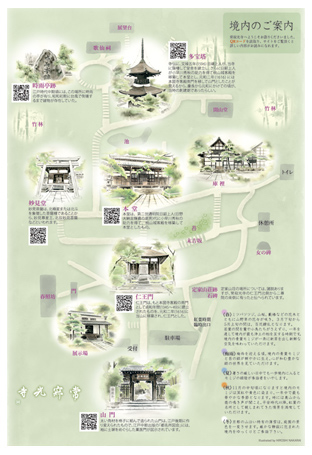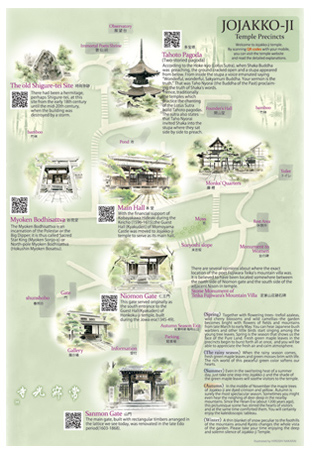境内のご案内 INSIDE MAP OF THE TEMPLE
境内のご案内
INSIDE MAP OF THE TEMPLE

仁王門
仁王門は、もと本圀寺客殿の南門として貞和年間(1345〜49)に建立されたものを、元和二年(1616)に当山に移築され、仁王門とした。 境内建築物の中で最も時代の古い建物である。茅葺の屋根がめずらしい。 仁王門像は、身の丈七尺、運慶の作と伝えられる。仁王門像は目と足腰の病にご利益があるとされ、近在の檀信徒がわらじを奉納して病気平癒を祈願されている。
常寂光寺妙見大菩薩縁起
妙見菩薩は、北極星または北斗を象徴した菩薩様であることから、妙見尊星王、北辰妙見菩薩などといわれます。
「七佛八菩薩所説大陀羅尼神咒経第二」によれば、妙見菩薩は衆聖中の最勝であり、よく国土を擁護し、また人の死を除き生を定め、福算を増益する尊星であると説かれています。
display: block; margin-top: 0.7em; margin-right: 2em; text-align: right; "> [続きを読む…]
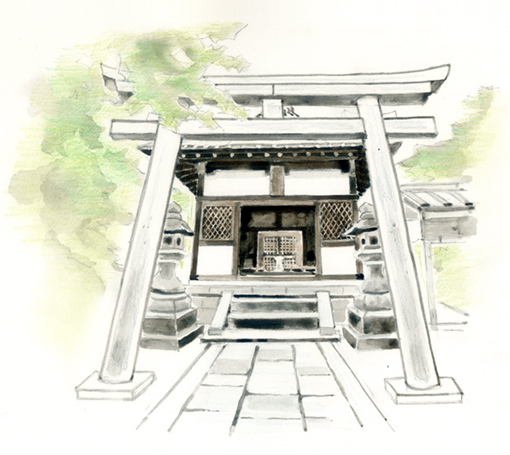
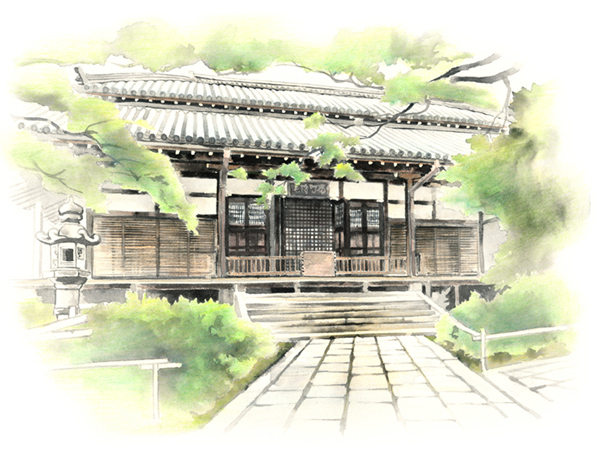
本堂
本堂は、第二世通明院日韶上人(日野大納言輝資の息男)代に小早川秀秋の助力を得て、桃山城客殿を移築して本堂としたもの。江戸期の文献、資料に図示された本堂の屋根は、本瓦葺きの二層屋根となっている。現在の平瓦葺きの屋根は、昭和七年の大修理の時に改修されました。建立の年代は、慶長年間。
鐘楼
鐘楼は、寛永十八年 (1642) 当山第四世、光照院日選上人の建立。梵鐘は第二次世界大戦中徴資に遭い、現在の梵鐘は、昭和四十八年に青木一郎博士の音響設計により、古律黄鐘調の新鐘として鋳造されたもの。毎日、正午と夕方五時に所定の数を突いています。
多宝塔
常寂光寺の多宝塔
中村 昌生
寺伝に、文禄五 (1596) 年日禛上人が、当寺に隠棲して堂舎を建立し、さらに日韶上人が小早川秀秋の助力を得て桃山城客殿を移築して本堂とし、元和二 (1616) 年には本圀寺客殿南門を移して仁王門としたことが見えるから、慶長から元和にかけての頃が、当時の創建期であったらしい。
display: block; margin-top: 0.7em; margin-right: 2em; text-align: right; "> [続きを読む…]
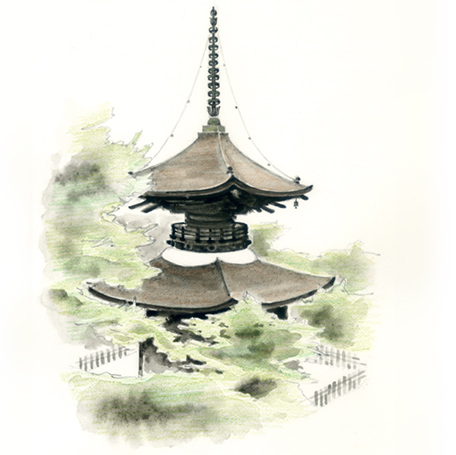
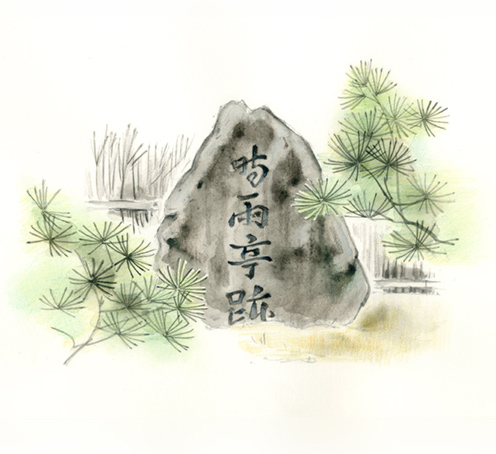
時雨亭跡
定家山荘の場所については、諸説ありますが、常寂光寺の仁王門北側から二尊院の南側に有ったと伝へられています。 この場所には、室町時代頃から定家卿の御神像を祀る祠が有りましたが、常寂光寺を創建する時に、定家卿の祠よりも上に寺の庫裏を建てるのは恐れ多いと現在の場所に遷座されました。 明治時代までは、小さな祠でしたが、明治23年に現在の大きさの建物に改築され、歌遷祠と呼ばれるようになりました。 歌遷祠の扁額は、富岡鐡齋の作。南隣に位置する時雨亭跡は、戦前までは庵室が建っていましたが、台風により倒壊してしまい、その後再建出来ず現在に至ります。 この庵室は、いつごろ建てられたか不明ですが、当山の古文書「双樹院日勝聖人傅」(1728年)の境内図には、この位置に庵が描かれています。又、「都名所図会」(1780年発行)にも庵が図示されていることから、江戸時代中期には建てられていたことが分かります。
Jojakko-ji Temple
Jojakko-ji Temple
It was founded by the 16th head priest of Honkoku-ji, Priest Nisshin, during the Keicho era (1596-1615). With the support of Kobayakawa Hideaki, the Guest Hall (Kyakuden) of Momoyama Castle was moved to this temple and became its main hall. The south gate (built during the mid-14th century) to the Guest Hall of Honkoku-ji temple, was moved to this temple in 1616 to serve as the Niomon gate. The Nio statues are attributed to the renowned 13th-century Buddhist sculptor Unkei (1151-1223). Among the temple treasures is a kurumagoto (small portable koto stringed instrument), which was granted to the lady Kogo-no-Tsubone by Emperor Takakura (1161-1181). The kurumagoto was then donated to this temple by Kobayakawa Hideaki. (It is not on public display.)
Main Gate
Main Gate
The main gate, built with rectangular timbers arranged in the lattice we see today, was renovated in the late Edo period (1603-1868). This Yakuimon-style gate was illustrated on the inner slip cover of the Miyako Meisho Zue (Guide to Famous Kyoto Sites) published in the mid-Edo period. At that time, there was a mud wall attached to the gate; after the renovation, it was removed.
This gate has an open feeling to it. Even when the door is closed, one can see the approach through the widely spaced framework of the black-painted door lattice.
display: block; margin-top: 0.7em; margin-right: 2em; text-align: right; "> [Read more ...]
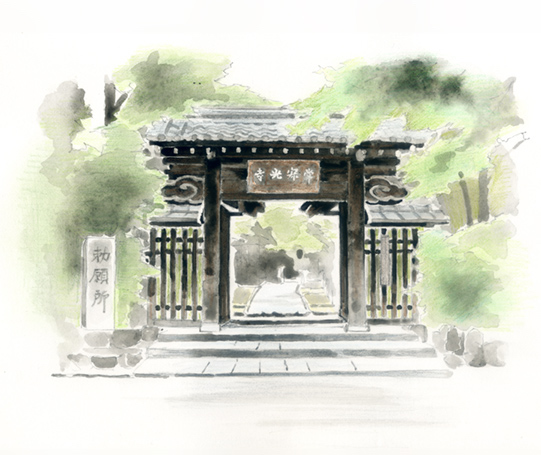

Niomon Gate
This gate served originally as the south entrance to the Guest Hall (Kyakuden) of Honkoku-ji temple, built during the Jowa era (1345-49). It was moved to Jojakko-ji in 1616 and made into the Niomon (a gate with Nio, two guardian gods). This is the oldest structure of all the buildings on the temple grounds. Its thatched roof is a rarity. The Nio statues are 210 cm tall, and are attributed to the renowned 13th-century Buddhist sculptor Unkei. Since Nio guardian gods are believed to have divine power to cure diseases of the eyes, lower back, and legs in particular, devotees in the neighboring towns come to offer a pair of straw sandals and pray for recovery from illness.
History of Myoken Bodhisattva in Jojakko-ji Temple
The Myoken Bodhisattva is an incarnation of the Polestar or the Big Dipper; it is thus called Sacred Star King (Myoken Sonjo-o) or North-pole Myoken Bodhisattva (Hokushin Myoken Bosatsu).
The “Dhāraṇī Jinju Sutra Preached by Seven Buddhas and Eight Bodhisattvas, Part 2” expounds that the Myoken Bodhisattva is the most eminent among all revered figures, and is thus regarded as a Sonjo, or sacred star, that protects the whole country. The sacred star is further said to vanquish death, enhance vital forces and increase one’s balance-sheet of happiness.
display: block; margin-top: 0.7em; margin-right: 2em; text-align: right; "> [Read more ...]


Main Hall
With the financial support of Kobayakawa Hideaki during the Keicho era (1596-1615), the Guest Hall (Kyakuden) of Momoyama Castle was moved to Jojakko-ji temple to serve as its main hall. This was the time of the 2nd priest, Nisho. According to illustrations found in literature and other material from the Edo period, the Main Hall had a two-layered hon-gawara-style roofing (the style using round and flat titles overlapping alternately). When major repairs to the Main Hall took place in 1932, it was converted to the present hira-gawara-style roofing (the style using flat tiles only).
Belfry
The belfry was constructed by the 4th chief priest, Nissen, in 1642. The original temple bell was appropriated during World War II to make use of its metal. The present bell was cast in 1973 under the design and supervision of Dr. Aoki Ichiro. It has the classic style of acoustics called ojikicho. Every day, the bell is struck at noon and at 5 pm.
Tahoto Pagoda (Two-storied pagoda)
According to the Hoke-kyo (Lotus Sutra), when Shaka Buddha was preaching, the ground cracked open and a stupa appeared from below.
From inside the stupa a voice emanated saying “Wonderful, wonderful, Sakyamuni Buddha. Your sermon is the truth.” That was Taho Nyorai (the Buddha of the Past) proclaiming the truth of Shaka's words. Hence, traditionally the temples which practice the chanting of the Lotus Sutra build Tahoto pagodas. The sutra also states that Taho Nyorai invited Shaka into the stupa where they sat side by side to preach.


Old Shigure-tei Site and Immortal Poets Shrine
There are several opinions about where the exact location of Shigure-tei, the poet Fujiwara Teika’s (1162-1241) mountain villa, used to be. It is believed to have been located somewhere between the north side of Niomon gate and the south side of the adjacent Nison-in temple.
In this same area there originally used to be a small shrine built some time during the Muromachi period (1392-1573), dedicated to Teika with his statue inside. Later, when Jojakko-ji temple was erected in 1596, the monks’ living quarters turned out to be located higher than this august shrine, so it was moved to the present site, higher on the hillside. At first, it was a miniature shrine, but was rebuilt in its present size in 1908. It has been called the Immortal Poets’ Shrine (Kasenshi) since then. The name plaque was written by the well-known ink painter Tomioka Tessai (1837-1924).
There also used to be a hermitage on one of the possible old Shigure-tei sites, immediate south of the Immortal Poets’ Shrine. It was destroyed by a typhoon in the early 20th century and has not been rebuilt. The construction date of this hermitage is unknown, but a map of the temple grounds included in an old document housed in this temple, Story of Sojuin Priest Nissho (1728), has an illustration of a hut in this location. The same building is also shown in Guide to Famous Kyoto Sites (1780). This proves that it was here as early as the mid-18th century.
